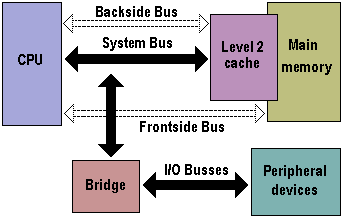A modern-day system can be viewed as comprising just two classes of bus: a System Bus, connecting the CPU to main memory and Level 2 cache, and a number of I/O Busses, connecting various peripheral devices to the CPU – the latter being connected to the system bus via a bridge, implemented in the processor’s chipset.

In Dual Independent Bus (DIB) architecture systems the single system bus is replaced by a frontside bus for shuttling data between the CPU and main memory, and between the CPU and peripheral buses and a backside bus for accessing Level 2 cache. The use of dual independent buses boosts performance, enabling the CPU to access data from either of its buses simultaneously and in parallel. Over time, the terms FSB and system bus came to be used interchangeably.
The evolution of PC bus systems over a period of more than a decade has given rise to a profusion of terminology, much of it confusing, redundant or obsolete. The system bus is often referred to as the main bus, processor bus or local bus. Alternative generic terminology for an I/O bus includes expansion bus, external bus, host bus as well as, rather confusingly, local bus.
A given system can use a number of different I/O bus systems and a typical arrangement is for the following to be implemented concurrently:
- an ISA Bus, the oldest, slowest and soon to become obsolete I/O Bus system
- a PCI Bus, present on Pentium-class systems since the mid-1990s
- a USB Bus, the replacement for the PC’s serial port which allows up to 127 devices to connected using either a hub device or by daisy-chaining.
- What Is The System Bus?
- ISA Bus – Industry Standard Architecture
- Local Bus Interfaces
- PCI Bus Interfaces
- What is AGP and AGP Pro?
- Internal Interfaces Summary
- PCI-X Interfaces
- PCI Express Interfaces
- IDE Interfaces
- EIDE Interfaces
- Hard Disks – What IS ATA and Ultra ATA?
- Serial ATA (SATA) interface guide
- SCSI Explained – With Pictures
- SCSI Interface Evolution
- Fibre Channel Interfaces
- Hard Disks – What is Serial Storage Architecture?
- I/O Interface Standards
- How It Works: The Idea and Technology Behind USB
- IEEE 1394 Interfaces
- USB 2.0 Intefaces
- FireWire 800 Interfaces